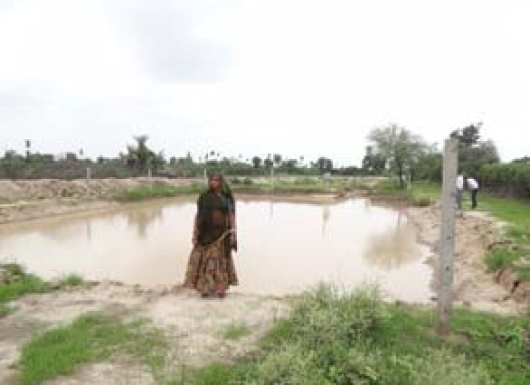Submitter: ICAR
Surface and groundwater water resources in most part of the hot arid zone of Rajasthan are very poor. With frequent droughts and chronic water shortages in many areas, most people pay an increasingly high price for the water. The poor, especially women and children, usually pay the highest price for small amounts of water. In absence of adequate surface and groundwater resources, rainwater if appropriately harvested can be a reliable source of potable water for domestic lifesaving purposes. Rainwater harvesting is collection and storage of rain from run-off areas such as roofs and other surface. If the collection and storage are designed scientifically, domestic water demand of a family can be met comfortably with rainfall as little as 100 mm per year on sustained basis. ICAR-Central Arid Zone Research Institute, Jodhpur over 6 decades of research has perfected the technology of rainwater harvesting through improved tanka for different users and purposes.

Traditionally tankas are generally open, rectangle in shape and constructed with lime mortar. There is no provision to control inflow of silt and life span of traditional tankas were limited with frequent maintenance. Improved tankas are superior to traditional tanka in terms of life span, maintenance, quality of water and economics.
Design Details of Improved Tanka
Tanka should be constructed at appropriate site depending on type of catchment. For runoff from rooftop, its location should be near to home while in case of runoff from natural catchment, tanka should be constructed at one side of depression area for maximum runoff and safe disposal of excess water.
Circular tanka is more economical in comparison to rectangular tanka of same capacity in term of cost of materials. Further rectangular tanka has tendency for development of cracks in four corners due to uneven distribution of pressure whereas in circular tanka pressure distribution is even thus less chance of cracks in sidewalls. Cement concrete is preferred over masonry construction due to cost and life span especially for larger tanka of capacity over 100000 litres.
Depth of tanka should be equal to diameter of tanka. Capacity should be based on no. of members in family and livestock. A 21000 litres capacity tanka is sufficient to meet the drinking water requirement of family of 6 persons for round the year. Bigger size tankas are more economical from construction and additional income generation point of view.
In western Rajasthan, a murrum layer is generally encountered in sub surface strata at many places. Special care is needed when tanka is to be constructed at these sites. Murrum has a tendency of swelling after getting some moisture and causes cracks especially in sidewalls. To avoid these cracks surrounding of whole tanka should have an envelope of 5 cm sand around sidewalls. In case of little leakage from sidewall, sand envelope of 5 cm thickness of sand will absorb the pressure exerted by the swelling of murrum around sidewalls and will prevent the cracks in sidewalls.
Key features of Improved Tanka
The technology of rainwater harvesting through improved tanka can efficiently works in any geographical location. In India it had worked successfully in entire hot arid region of with annual rainfall less than 400 mm in the states of Rajasthan, Haryana, Gujarat, Karnataka. Larger size tanka can constructed for community need and providing lifesaving irrigation to small orchard or horticultural plants. Payback period is about 3 to 4 years if harvested water is used for providing supplemental irrigation to nearby horticultural plants and raising nursery.
The improved tanka design developed by ICAR-CAZRI has got wide acceptance in the arid region. The designs have been replicated in large numbers by different developmental agencies. The improved tanka design were adopted by Govt. of India under Rajeev Gandhi Drinking Water mission. State soil and water conservation departments are constructing these types of tanka under watershed programs. As per one estimate the number of improved tankas of different capacities constructed in the region were more than 11,469 with a total storage capacity of 4,75,200 cubic meters and are sufficient to meet the drinking and cooking water requirements for a population of 1,32,000 throughout the year. Assured availability of water at home is source of pride and sense of self sufficiency for the family.
The technology of rainwater harvesting through improved tanka is scalable to any geographical area of the world with limited availability of surface and groundwater resources or poor quality of groundwater in area with rainfall as little as 200 mm. The technology can meet round the year drinking water requirement for entire family of 6-8 persons with limited rooftop or catchment area on sustainable basis. There is no technological constraint in adoption of technology of improved tanka. Locally available construction materials like stone, cement, concrete and local mason can construct the tanka as per given improved design. However some farmers may need financial support from the Government in terms of subsidy.
Dr. R.K.Goyal, Principal Scientist ICAR-CAZRI, Jodhpur 342003
Mobile – 9414410251
Email: rkgoyal24@gmail.com
Additional Information